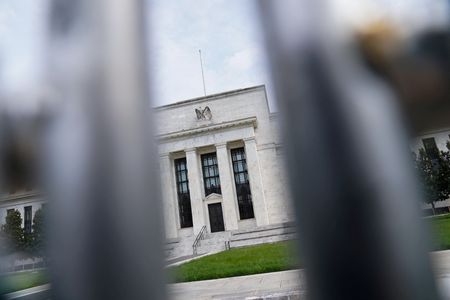By Howard Schneider
WASHINGTON (Reuters) -A year after U.S. inflation peaked and touched off an aggressive turn in monetary policy, Federal Reserve officials may be opening a more encouraging chapter in their policy discussion with the first of what analysts expect to be a run of data showing key price measures in steady decline.
The U.S. Labor Department on Wednesday reported the consumer price index rose at an annual rate of 3% in June, below economists’ expectations in a Reuters poll and the lowest reading since March 2021. It marked a material leg down in a figure that had clocked in at 4% in May and had topped 9% in June 2022, which was the highest in four decades.
A separate measure of underlying inflation, stripped of items like energy and food that are tied to world commodity markets, eased to 4.8% from 5.3% in May, with the drop being the largest in more than three years.
It may be just the start of what economists are beginning to frame as a more durable “disinflation” as the impact of the U.S. central bank’s policy tightening over the last year begins to show itself in slower hiring and weaker demand.
There were outright price declines in many goods in June, only a modest increase in food costs, and evidence that the pace of price hikes was slowing in the service sector, an area of the economy Fed officials have worried would be difficult to budge.
Omair Sharif, president of Inflation Insights, noted that prices had barely increased at all last month for services outside of housing and energy, and he expected continued weakness.
That could help lower overall inflation when the next CPI report is released on Aug. 10, with the details in Wednesday’s report suggesting “downside risks” to any forecast of July’s inflation rate.
The June report is the “first of what we anticipate will become a trend toward closer-to-target levels of inflation,” said Rick Rieder, chief investment officer of global fixed income at BlackRock. “We should see these types of numbers over the coming months ahead across domestic inflation prints.”
Lael Brainard, a former Fed vice chair who is now the director of the White House’s National Economic Council, touted the CPI release as evidence that the country was winning its inflation fight without heavy pain in the labor market.
“The economy is defying predictions that inflation wouldn’t fall absent significant job destruction,” Brainard said at an event held by the Economic Club of New York. “Just today we saw new and encouraging evidence that the economy is on the path to moderate inflation accompanied by a resilient jobs market.”
A month of good inflation news, however, is unlikely to dissuade the Fed from raising its benchmark overnight interest rate by another quarter of a percentage point to the 5.25%-5.50% range at its July 25-26 policy meeting. Investors on Wednesday still put more than a 90% probability on such a move.
Indeed, at least one Fed official on Wednesday stuck to policymakers’ prevailing hawkish mantra that inflation is still too high.
While not specifically addressing the CPI report, Richmond Fed President Thomas Barkin told a Maryland business group that he still felt inflation had “been stubbornly persistent.”
“No matter how you cut it, inflation has been too high,” he said, adding that he agreed that overall demand was beginning to slow, but he wanted to be “convinced” by incoming data that it would translate into lower inflation.
The Fed has a 2% inflation target measured against the separate personal consumption expenditures price index, and a closely watched version of it, also stripped of volatile food and energy prices, has been lodged at around 4.6% since December.
U.S. central bank officials have said they need to see steady declines in that data to be comfortable that inflation is under control and on a sustainable path back to the 2% target.
‘FINAL INNINGS’
But the latest CPI data could undercut arguments for yet another rate increase beyond the July meeting.
“Today’s report is consistent with our view that Fed tightening is in its final innings,” economists from Goldman Sachs wrote, with a quarter-percentage-point hike expected in July “followed by unchanged policy for the remainder of the year.”
Recent data have been somewhat ambiguous – slowing overall job growth, for example, coupled with still strong wage increases that some officials worry could feed future inflation; an improved mood in recent small business surveys offering evidence of economic resilience, but a boost as well in the share of business owners planning to raise prices.
But, importantly, public expectations about inflation have remained under control. A study released this week from the Cleveland Fed’s Center for Inflation Research found the long-term inflation outlook was “anchored near the Federal Reserve’s 2% target,” a finding generally shared by Fed policymakers who consider any move higher in public inflation expectations a warning that inflation itself may accelerate.
The calendar is also turning in the Fed’s favor, with some of the worst inflation readings falling from the calculations of annual price increases, and recent, weaker data on rental costs set to become more prominent in the numbers.
Fed officials, blindsided by the persistence of inflation they initially thought would dissipate on its own, have been reluctant to bank on good news continuing. Far from declaring victory over inflation, they’ve focused on the risks that it might resurge, worried over its stubbornness, and have been more likely than not to pencil in higher interest rates if there was any doubt.
The June data may change the tone.
In comments this week, prior to the release of the CPI data, Atlanta Fed President Raphael Bostic said he felt the central bank now “had momentum” in its inflation fight and, in his view, won’t have to raise rates again.
“The underlying data is actually telling a very positive story,” Bostic said.
(Reporting by Howard Schneider;Additional reporting by Michael S. Derby and Ann Saphir;Editing by Dan Burns and Paul Simao)





